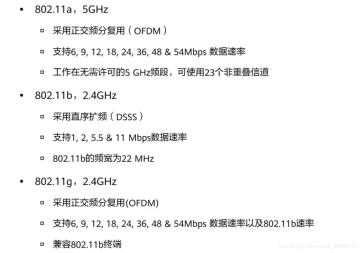IEEE 802.11b/IEEE 802.11g Protocols Explanations
1. IEEE802.11b and IEEE802.11g are both used in the 2.4GHz frequency band. Let’s explain these two protocols in a continuous way so that we can understand the standards of different protocols.
IEEE 802.11b is a standard for wireless local area networks. Its carrier frequency is 2.4GHz, and it can provide multiple transmission speeds of 1, 2, 5.5, and 11 mbit/s, up to 11 mbit/s. Its release time is 5 times faster than the IEEE 802.11 standard just approved two years ago, which has expanded the application field of wireless local area networks and provided basic support for higher transmission rates. In use, different bandwidths of 5.5 Mbps, 2 Mbps, and 1 Mbps can be used according to the actual situation. After actual testing, the actual working speed is about 5 MB/s, which is almost at the same level as the ordinary 10Base-T cable LAN. In the ISM band of 2.4GHz, there are 11 channels with a bandwidth of 22mhz available, which are 11 overlapping bands. The successor standard to IEEE 802.11b is IEEE 802.11g.
2. IEEE 802.11g was adopted in July 2003. The carrier frequency is 2.4GHz (the same as 802.11b), and there are 14 frequency bands. The original transmission speed is 54 Mbit/s, and the net transmission speed is about 24.7 Mbit/s (the same as 802.11a). The 802.11g device is downward compatible with 802.11b.
Since then, some wireless router manufacturers have developed new standards based on the IEEE 802.11g standard to meet the market’s needs and have increased the theoretical transmission speed to 108 mbit/s or 125 mbit/s. Currently, there are follow-up protocols such as IEEE 802.ax that involve WiFi 6 or above, which are all optimized in the PHY layer to increase the speed to more than a Gigabit, so we will not discuss them here.

The following picture is a summary of IEEE802.11a IEEE802.11b IEEE802.11g:
The above is the knowledge explanation of IEEE 802.11b/IEEE 802.11g brought by Shenzhen HDV Phoelectron Technology Co., Ltd. hope this article can help you to increase your knowledge. Besides this article if you’re looking for a good optical fiber communication equipment manufacturer company you may consider about us.
The communication products produced by the company cover:
Module: optical fiber modules, Ethernet modules, optical fiber transceiver modules, optical fiber access modules, SSFP optical modules, and SFP optical fibers, etc.
ONU category: EPON ONU, AC ONU, optical fiber ONU, CATV ONU, GPON ONU, XPON ONU, etc.
OLT class: OLT switch, GPON OLT, EPON OLT, communication OLT, etc.
The above products can support different network scenarios. For the above products, a professional and powerful R & D team is paired to provide technical support for customers, and a thoughtful and professional business team can provide high-quality services for customers’ early consultation and later work.
